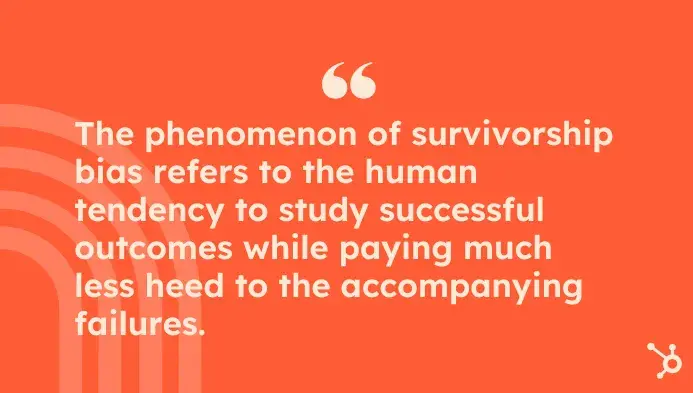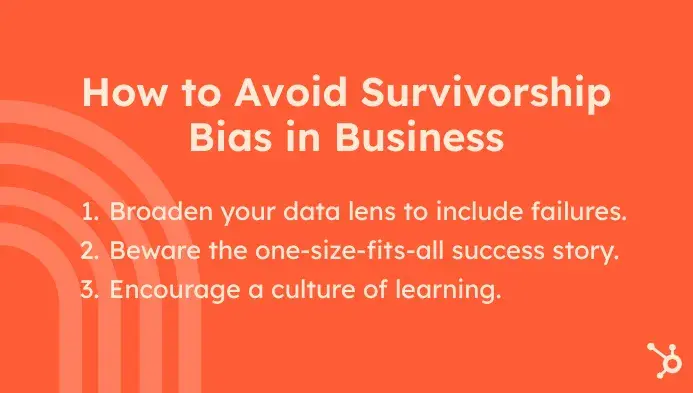Early on in my sales career, I landed a big (at the time) deal after cold emailing about 30 prospects using a certain template. That one win had me convinced I’d cracked the code. I believed if the messaging worked for me once, it would work over and over, which is why it took me way too long to admit to myself that it was flopping besides the single exception.
I was reluctant to try other messaging tactics because I had fallen victim to survivorship bias before I even knew what it was. What is survivorship bias? Thanks to that experience and many other subsequent ones, I feel qualified to tell you — and share some tips on how to avoid it.
Table of Contents
- What is survivorship bias?
- Survivorship Bias and Sales
- Examples of Survivorship Bias
- How to Avoid Survivorship Bias in Business
- To thrive, go beyond mere survival.
The idea rose to prominence in WWII, when Allied forces were deciding where to add armor to the tattered planes that were barely returning from bombing missions over Europe.
Initially, engineers felt it was logical to add armor to the areas where returning planes had been shot the most — but statistician Abraham Wald pointed out the error in this thinking. Because the analysts were only able to look at the planes that had returned, Wald argued they should actually reinforce the parts of the planes that were relatively unscathed. If those parts had been hit, he reasoned, the damage would’ve been fatal, and the planes wouldn’t have made it back at all.

This phenomenon of survivorship bias refers to the human tendency to study successful outcomes while paying much less heed to the accompanying failures. Because of this, we adopt opinions, structure businesses, and make decisions without examining all the data, which can easily lead us astray.
Check out this TED Talk for more on the survivorship bias.
Missing what’s missing: How survivorship bias skews our perception | David McRaney | TEDxJackson
So, how does survivorship bias apply to the world of sales?
Survivorship Bias and Sales
Sales is a very dynamic field, which should be no surprise because sales performance is so closely tied to revenue. To keep growing (and keep those pesky shareholders happy), companies are constantly experimenting with ways to boost sales and generate more revenue at a relatively smaller expense.
Sales contributors often experience the pressure in the form of ever-increasing quotas or questionable new strategies decreed from on high, while sales leaders are frequently the ones in the alchemist’s lab trying to replicate previous successes and find the next big source of closed deals. Unfortunately, the sales pressure cooker can regularly cause people to focus on the wrong things, which is why it’s common for salespeople at all levels to fall prey to survivorship bias.
You may recognize some of the following examples that I’ve either experienced myself or heard of colleagues encountering.
Examples of Survivorship Bias
1. “Steve Jobs, Bill Gates, and Mark Zuckerberg dropped out of college and became wildly successful — so I will, too.”
A quick Google search of “Successful founders who dropped out of college” will yield some of the most well-known names in the world. Jobs, Gates, and Zuckerberg are all examples of entrepreneurs who had an idea, took a leap, and, miraculously, became successful.
Unfortunately, by equating all their success to hard work alone, we ignore a very important fact: For every highly successful college dropout, there are hundreds or even thousands who have a different experience. Graduates with a bachelor’s degree make a median $77,636 compared to just $46,748 for those without according to U.S. BLS (Bureau of Labor Statistics) data, and despite the growing price of higher education, a 2023 report from the Federal Reserve illustrates that a majority of college graduates still feel the investment was worth it.
Assuming a college degree isn’t necessary to be successful is an example of survivorship bias. While it might not be right for everyone, it’s important to look at all of the available facts before coming to a decision.
2. “If I read the biographies of the world’s most successful entrepreneurs, I’ll understand how to be successful.”
“The Morning Habits of Successful People.” “The Six Characteristics All Billionaires Have in Common.” “The One Thing Jeff Bezos Says Made Him Successful.” I’ll admit falling victim to this clickbait every once in a while, and I bet you have, too.
We love to think that learning about our idols will enable us to emulate their success. The problem is that these articles — and even deep-dive biographies — don’t present all the facts necessary to draw real conclusions. We overlook the variables the author didn’t include, and even more importantly, ignore the hundreds of people who likely tried and failed to build companies like Amazon before Bezos did.
“The One Trait Almost All Billionaires Share?” Probably a whale of an inheritance if we’re being honest.
3. “If I pattern my company after Warby Parker, I’ll be successful.”
“The next Netflix.” “The Uber of [fill in the blank of an industry].” Survivorship bias in business leads many founders to try to fit their business into a model that just isn’t right for the current market, their audience, or their growth stage.
2024 data from the U.S. BLS tells us 20.4% of businesses fail in year one, 49.4% fail in the first five, and 65.3% fail in the first 10. That’s only two-thirds of all businesses survive two years, half of all businesses survive at least five years, and one-third of all businesses survive at least 10 years.
Can you succeed? Absolutely, but modeling your company after one that’s been a success doesn’t guarantee anything. When starting a new business, draw inspiration from the companies you admire, but assess the market to understand how you’ll need to adjust to fit your own use case.
4. “My product is better than their product, so I’ll succeed.”
Here’s one that salespeople know all too well. The reality is that most products on the market are about average (that’s sort of the definition, right?), and it’s easy to assume the grass is always greener and the competitor selling their solution with more features and better implementation has it easy.
Most of us eventually find out that a better product doesn’t necessarily produce a better business, and there’s a lot more to success than the right bells and whistles. That product you have that’s so great? There are probably several that have been created that were even better than yours, but you’re not aware of them because the hopeful young startups behind them never took off.
5. “Sales team X used these email templates to increase close rates by 35%. I’ll use these templates and get the same results.”
Almost as prevalent as articles about successful people’s morning routines? Articles telling you how one company made a single change and saw exponential returns — and how you can, too. But if survivorship bias in business teaches us anything, it’s that we must consider the other businesses who tried the same fix and saw lackluster results.
Maybe the sales team in question really did see a 35% close rate by using these templates — but what might not be included in the article is the fact that they also brought on a new sales executive, changed their compensation structure, and happened to close a few big deals that quarter that had been stalled for months.
To assume their 35% close rate increase was due solely to generic outbound messaging, and to assume that messaging would work the same way for your business? You’re likely headed toward disappointment.
6. “I’ll calculate ARR based on our current customers.”
If you’re calculating annual recurring revenue (ARR) based on your current customer base alone, you may be poised for a harsh reality when your actual revenue comes up short.
While focusing on current clients is key to business planning, our knowledge of survivorship bias encourages us to study the customer churn rate of the same time last year and factor that into our ARR calculations.
This gives us a more accurate picture of what the company can expect to bring in and avoids disappointments or unexpected cash flow shortages down the line.
7. “If I focus on my unhappy customers, I’ll be able to retain them and decrease my churn rate.”
If you wait until an unhappy customer complains before engaging with them to reduce churn, you’ve likely already lost their business. Don’t assume everything is great with your customer simply because they’re not actively sending angry emails. Instead, use tools like the Net Promoter Score® (NPS®) to measure customer satisfaction and growth potential.
By taking the pulse of your current, happy clients, you can spot earlier signs of unrest and proactively address customer issues as they arise — instead of running to catch up to customers when they already have one foot out the door.
8. “Our customers are requesting these features, so we should add them to our product/service.”
This one has a special place in my heart, and feature creep is a stumbling block most founders face during the lifespan of their company. It’s what happens when you begin to build or implement features outside your company’s scope simply because you’ve received requests from your customers.
While it’s important to keep a pulse on the market, your competitors, and the needs of your customers, it’s equally important to stay focused on your core company mission. Everything has an opportunity cost, and if certain requested features distract your dev team from the growth of your core product/service, they’re not worth the time and effort they’ll require or the few clients they’ll win over.
Now that we’ve identified some of the most common assumptions founded on survivorship bias, I’m going to outline a few strategies for avoiding it.
How to Avoid Survivorship Bias in Business
Survivorship bias in business can be sneaky, but it’s preventable once you know how to approach decisions. Here are some techniques I use to ensure I’m seeing the whole picture and not just the survivors.

1. Broaden your data lens to include failures.
In sales, we celebrate wins loudly, but losses often happen quietly — and it’s no different when we’re examining results after the fact. Want to avoid survivorship bias? Look at all the data instead of just the success stories.
In practical terms, I force myself to review lost deals, missed opportunities, and failures with the same rigor as I do wins. Instead of quarterly reviews containing a highlight reel of our biggest sales, I also run reports on the deals that didn’t close.
Using HubSpot’s Sales Hub, I pull a report of all Closed-Lost deals with their reasons for loss. This is humbling but incredibly insightful. In one quarter last year almost all of our wins all came from a new industry segment — we were about to double-down on it, thinking we’d found a gold mine, but the full funnel data showed three times as many lost deals in that segment that we’d swept under the rug. Ultimately, the wins were nice, but not worth pivoting our sales strategy for.
2. Beware the one-size-fits-all success story.
In the age of LinkedIn and the constant content stream, there’s no shortage of success stories and best practices being shared. Sales LinkedIn is particularly notorious, and every week I stumble on posts like “We used this one email subject line and got a 50% higher reply rate.”
Gather ideas from everywhere, but I take these pieces of “advice” with a very large grain of salt. No single success story automatically fits all situations, and one of the key ways to avoid survivorship bias is to remember context is king.
Just like different outreach tools perform better in certain industries, the same messaging playbook that earns meetings with small business owners might fall completely flat if you try it on C-suite executives.
When a survivor’s tactic works well in one context, it might very well fail in another. When I see a success story, I always wonder what they’re not telling me. Sure, Ray Dalio meditates — and yet, none of the meditation proponents I know are billionaires.
3. Encourage a culture of learning.
Avoiding survivorship bias isn’t just a one-person job. I’ve found that fostering a team culture where we openly discuss both successes and failures helps inoculate everyone against survivorship bias. How do you pull this off? Lead by example and start sharing your own screw-ups.
When the team is willing to examine losses, you’re well on your way to a successful sales department. Mistakes will always happen — but you’re only doomed when the same ones are happening over and over and over again.
Share the failures, learn the lessons, and make sure they’re cemented in the collective memory of the sales team. Knowing what to do also means knowing what not to do.
To thrive, go beyond mere survival.
In sales (and in business), you win more in the long run by learning why others lost. I carry that lesson with me every day. When I review my pipeline, I don’t just see numbers — I see the collective memory of our team’s wins and losses, with both successes and failures creating valuable data points.
By trying to consciously avoid survivorship bias, I think I’ve found a clearer, steadier path to growth.
The next time you find yourself bedazzled by a success story (be it a competitor’s, a colleague’s, or your own), take a moment to ask: What am I not seeing? Who tried this and didn’t succeed, and what can I learn from them?
That simple shift in mindset can save you from painful mistakes and guide you toward strategies that truly work for your business.
![]()


